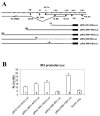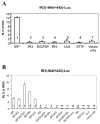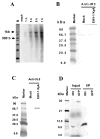The equine herpesvirus-1 IR3 gene that lies antisense to the sole immediate-early (IE) gene is trans-activated by the IE protein, and is poorly expressed to a protein
- PMID: 17306852
- PMCID: PMC1939811
- DOI: 10.1016/j.virol.2007.01.024
The equine herpesvirus-1 IR3 gene that lies antisense to the sole immediate-early (IE) gene is trans-activated by the IE protein, and is poorly expressed to a protein
Abstract
The unique IR3 gene of equine herpesvirus 1 (EHV-1) is expressed as a late 1.0-kb transcript. Previous studies confirmed the IR3 transcription initiation site and tentatively identified other cis-acting elements specific to IR3 such as a TATA box, a 443 base pair 5'untranslated region (UTR), a 285 base pair open reading frame (ORF), and a poly adenylation (A) signal [Holden, V.R., Harty, R.N., Yalamanchili, R.R., O'Callaghan, D.J., 1992. The IR3 gene of equine herpesvirus type 1: a unique gene regulated by sequences within the intron of the immediate-early gene. DNA Seq. 3, 143-152]. Transient transfection assays revealed that the IR3 promoter is strongly trans-activated by the IE protein (IEP) and that coexpression of the IEP with the early EICP0 and IR4 regulatory proteins results in maximal trans-activation of the IR3 promoter. Gel shift assays revealed that the IEP directly binds to the IR3 promoter region. Western blot analysis showed that the IR3 protein produced in E. coli was detected by antibodies to IR3 synthetic peptides; however, the IR3 protein was not detected in EHV-1 infected cell extracts by these same anti-IR3 antibodies, even though the IR3 transcript was detected by northern blot. These findings suggest that the IR3 may not be expressed to a protein. Expression of an IR3/GFP fusion gene was not observed, but expression of a GFP/IR3 fusion gene was detected by fluorescent microscopy. In further attempts to detect the IR3/GFP fusion protein using anti-GFP antibody, western blot analysis showed that the IR3/GFP fusion protein was not detected in vivo. Interestingly, a truncated form of the GFP/IR3 protein was synthesized from the GFP/IR3 fusion gene. However, GFP/IR3 and IR3/GFP fusion proteins of the predicted sizes were synthesized by in vitro coupled transcription and translation of the fusion genes, suggesting poor expression of the IR3 protein in vivo. The possible role of the IR3 transcript in EHV-1 infection is discussed.
Figures








Similar articles
-
Characterization of the regulatory function of the ICP22 protein of equine herpesvirus type 1.Virology. 1995 Jul 10;210(2):273-82. doi: 10.1006/viro.1995.1344. Virology. 1995. PMID: 7618267
-
Interaction of the equine herpesvirus 1 EICP0 protein with the immediate-early (IE) protein, TFIIB, and TBP may mediate the antagonism between the IE and EICP0 proteins.J Virol. 2003 Feb;77(4):2675-85. doi: 10.1128/jvi.77.4.2675-2685.2003. J Virol. 2003. PMID: 12552007 Free PMC article.
-
Characterization of the trans-activation properties of equine herpesvirus 1 EICP0 protein.J Virol. 2000 Feb;74(3):1200-8. doi: 10.1128/jvi.74.3.1200-1208.2000. J Virol. 2000. PMID: 10627530 Free PMC article.
-
The gamma2 late glycoprotein K promoter of equine herpesvirus 1 is differentially regulated by the IE and EICP0 proteins.Virology. 1999 Apr 10;256(2):173-9. doi: 10.1006/viro.1999.9608. Virology. 1999. PMID: 10191181
-
Expression of an equine herpesvirus 1 ICP22/ICP27 hybrid protein encoded by defective interfering particles associated with persistent infection.J Virol. 1996 Jan;70(1):313-20. doi: 10.1128/JVI.70.1.313-320.1996. J Virol. 1996. PMID: 8523542 Free PMC article.
Cited by
-
The early UL3 gene of equine herpesvirus-1 encodes a tegument protein not essential for replication or virulence in the mouse.Virology. 2011 Nov 10;420(1):20-31. doi: 10.1016/j.virol.2011.08.016. Epub 2011 Sep 13. Virology. 2011. PMID: 21917286 Free PMC article.
-
Characterization of cis-acting elements required for autorepression of the equine herpesvirus 1 IE gene.Virus Res. 2012 Apr;165(1):52-60. doi: 10.1016/j.virusres.2012.01.005. Epub 2012 Jan 14. Virus Res. 2012. PMID: 22265772 Free PMC article.
-
Comparative Genomic Sequencing and Pathogenic Properties of Equine Herpesvirus 1 KyA and RacL11.Front Vet Sci. 2017 Dec 11;4:211. doi: 10.3389/fvets.2017.00211. eCollection 2017. Front Vet Sci. 2017. PMID: 29312962 Free PMC article.
-
The EHV-1 UL4 protein that tempers viral gene expression interacts with cellular transcription factors.Virology. 2014 Jan 20;449:25-34. doi: 10.1016/j.virol.2013.11.005. Epub 2013 Nov 21. Virology. 2014. PMID: 24418534 Free PMC article.
-
The Genomic Characterization of Equid Alphaherpesviruses: Structure, Function, and Genetic Similarity.Vet Sci. 2025 Mar 3;12(3):228. doi: 10.3390/vetsci12030228. Vet Sci. 2025. PMID: 40266963 Free PMC article. Review.
References
-
- Alam J, Cook JL. Reporter genes: application to the study of mammalian gene transcription. Anal Biochem. 1990;188:245–254. - PubMed
-
- Albrecht RA, Jang HK, Kim SK, O’Callaghan DJ. Direct interaction of TFIIB and the IE protein of equine herpesvirus 1 is required for maximal trans- activation function. Virology. 2003;316:302–312. - PubMed
-
- Albrecht RA, Kim SK, O’Callaghan DJ. The EICP27 protein of equine herpesvirus 1 is recruited to viral promoters by its interaction with the immediate-early protein. Virology. 2005;333:74–87. - PubMed
-
- Albrecht RA, Kim SK, Zhang Y, Zhao Y, O’Callaghan DJ. The equine herpesvirus 1 EICP27 protein enhances gene expression via an interaction with TATA box-binding protein. Virology. 2004;324:311–326. - PubMed
MeSH terms
Substances
Grants and funding
LinkOut - more resources
Full Text Sources

